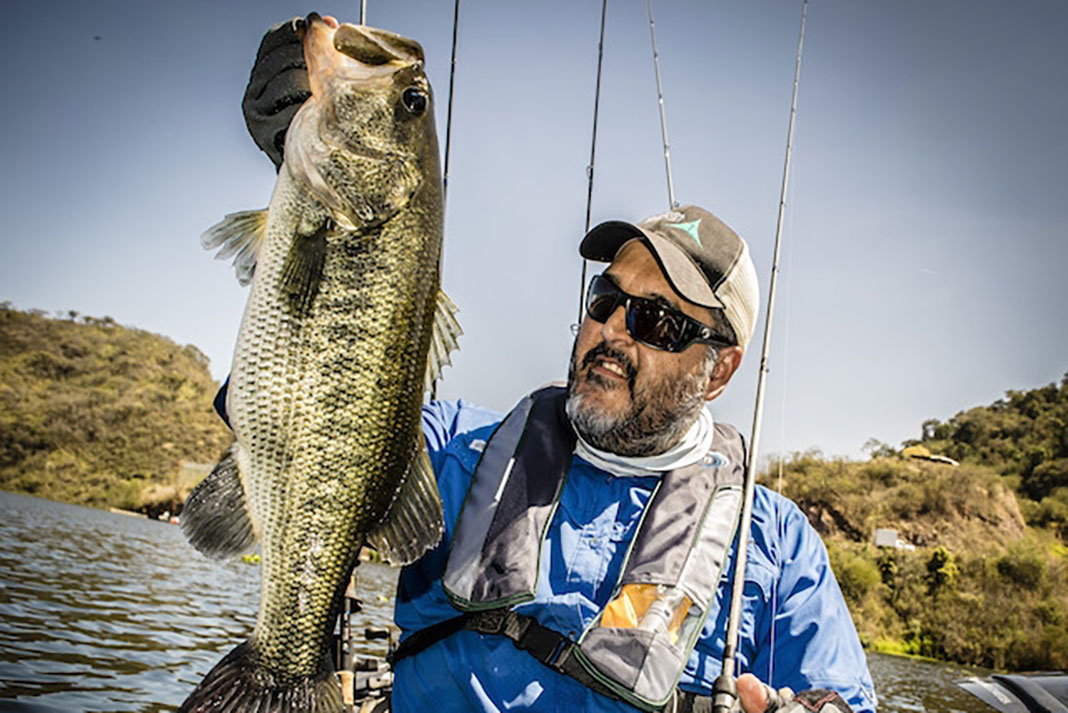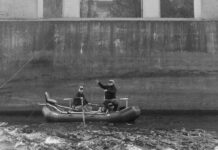Peanut butter and chocolate. Bert and Ernie. Bass and plastics. Some pairings are just about perfect. The problem when bass fishing, I’ve learned, is that there are more than a dozen ways to rig up a hook, sinker and soft plastic bait. So, how do you choose the best setup for the day? This guide is here to help by walking through the best bass fishing rigs.
Best for Beginners
Texas Rig
The first bass fishing rig that most anglers learn is the Texas rig. When I first graduated from bobbers and nightcrawlers, I turned to a Texas-rigged worm at Hooky’s pond, inching it through the underwater maze of Christmas trees and pheasant cages that bass claimed for cover. Part of the Texas rig’s appeal is its simplicity.

Tying a Texas Rig
- Thread a bullet sinker through your line.
- Tie on a worm hook.
- Slide hook into your plastic worm, crawdad, or creature bait with the hook tip buried in the plastic body.
With that thin profile and embedded hook, the Texas Rig is relatively weedless and snag-resistant—built to cast into the cabbage and tip-toe through timber to pull out Ole Bucketmouth with a baitcasting rod or medium-heavy spinning rod.
Tactic Tip
Fish Texas-rigged plastics slowly. A tried-and-true retrieve is to keep your rod tip up around 2:00, slowly raise it to 12:00, and then drop it back to 2:00, reeling in your slack. Bass can hit on the rise or the fall.
Fished from a boat or the bank, the Texas Rig is made to comb through cover and slay largemouth in the salad, where other rigs get hung up.
Best for Covering Water
Carolina Rig
Texas rigs are best for fishing heavy cover. Carolina rigs are best for covering water.
Carolina rigs were all the rage in the ‘80s—back when old-school fishing shows with Roland Martin and Jimmy Houston followed my Saturday morning cartoons. Like the Texas rig, the Carolina rig consists of a sinker, hook, and soft plastic, but it adds a bead, swivel, and leader to free your plastic worm, fluke, lizard, or creature bait to swim without being burdened by the sinker.

Tying a Carolina Rig
- Slip your egg (or bullet) sinker onto the line.
- Slide a bead below the sinker.
- Tie a barrel swivel to the end of the line.
- Tie a (short or long) monofilament leader below the swivel.
- Tie a wide gap (2/0 or 3/0) hook to the end of your leader.
- Attach your go-to soft plastic for bass fishing.
Tactic Tip
To fish a Carolina rig, start with a long cast. Let the weighted plastic sink, and slowly drag it along the bottom. Stop it when you bump into cover. This retrieve lets bass anglers trace the contours of the lake and float an undulating plastic around underwater humps, stumps, points, and shelves.
Good for all bass species, the Carolina rig works with most soft plastics—giving them a more natural presentation than lures rigged up snug against their sinkers.
Best for Vertical Fishing
Drop Shot Rig
The drop shot rig is another top bass fishing rig that separates the soft plastic from the sinker—in this case, to fish vertically and finesse bites out of pressured or suspended bass.
With drop-shotting, the lure rides above the sinker, which acts as an anchor to keep your lure suspended off the bottom, either above cover or next to cover. Given its vertical orientation, I prefer fishing drop shot rigs from a fishing kayak or bass boat.
You’ll tie a drop shot rig leaving a long tag line below your hook that equals whatever distance you want to suspend your lure above the bottom.
Tactic Tip
The staple drop shot presentation is to drop your rig next to the structure you want to fish or position the plastic body just above the suspended fish you’ve graphed on your fish finder. Let the sinker anchor your lure where it will torment largemouth, smallmouth, or spotted bass with the slow movements of an injured or dying baitfish. If you need to give your lure a little action, subtly shake your rod tip to give that worm or minnow imitation a little gyration. When a fish hits, pause, reel in slack line, and lift the rod tip to set the hook.
The main reason to fish a drop-shot rig is to tempt hard-to-catch bass with an easy target and a natural presentation. It may have a little bit of a learning curve, but drop-shotting is one of the best techniques for finesse fishing pressured, finicky, and suspended fish in open water.
Best Multi-species Slayer
Ned Rig

Another finesse system, the Ned rig is a smallmouth-slayer and multi-species fish catcher.
Named after Kansas angler Ned Kehde, the Ned rig refers to a soft plastic slipped onto a mushroom-shaped Ned rig jig head. A 3- or 4-inch stick worm is the staple Ned rig plastic, but you can switch things up with a smaller tube, creature bait, or minnow-style plastic, too.
Tactic Tip
Cast out the rig and let it drop naturally with a little slack in your line. Bass often hit Ned rigs on the fall, so watch your line and maintain enough feel as it falls to detect a subtle strike or a line swimming sideways. Pause for a few counts on the bottom before slowly working the rig back to you with a lift-and-drop retrieve or a stop-go cadence with plenty of pauses.
This is an unassuming bass fishing rig that you can choose to target spooked fish in the shallows or pressured fish around deep-water structure. You can catch the occasional pig Ned-rigging, but it’s more of a numbers rig for anglers who want to lift more fish into the boat.
If you’re not a Ned Head now, you soon will be after trying this subtle-but-deadly presentation for largemouth, smallmouth, and spotted bass (as well as other species). Read a complete guide to rigging and fishing the Ned rig.
Best for Spring Spawning Days
Wacky Rig
Imagine drunks too hammered to thread a plastic worm properly onto a hook, so they simply stick a hook through the fattest part of the worm and cast it out. Well, that’s more or less how to rig a wacky rig.

A wacky rig isn’t much of a “rig” at all—you really do just shove a hook through the belly of a soft stick bait. However, that simple rigging often results in bass shaking the plastic off the hook mid-fight. So many wacky-riggers opt for a similar presentation that adds a small O-ring to secure the hook on top of the plastic.
Tactic Tip
Another finesse presentation, wacky-rigging works best when anglers let the rig do the work. Simply cast or pitch a wacky-rigged Senko (or another worm lure) toward spawning beds, docks, and visible bass, and let it sink. The flutter of that slow-falling, drunk-rigged plastic is what makes wary bass fall for the wacky rig. They’re attracted to that subtle shimmy as the worm slowly sinks and dances down the water column.
If you don’t get a strike as the wacky rig sinks, try a few subtle twitches with the lure sitting on the bottom. Lift it once or twice. No need to work it–less is more when wacky rigging.
The wacky rig is bomber for spring fishing in the shallows. If you’re fishing spawning or spawned out bass—or finesse fishing pressured largemouth or smallmouth—the wacky rig isn’t a wacky choice at all.
Best for Throwing the Whole Kitchen Sink
Alabama Rig
Wacky in its own right, the Alabama rig is not at all a finesse rig—it’s an attractor rig consisting of a wire harness system that lets anglers rig up five or more lures at once to mimic a school of minnows. A word of caution, Alabama rigs aren’t legal in some states that limit how many hooks or lures you can fish at once. However, they can be killer on bass indulging on baitfish.

Alabama Rig Setup
Alabama rigs call for long stiff rods and strong line to lob this heavy lure hauler without snapping. They look like complicated contraptions. However, they’re easy to set up:
- Tie the Alabama rig to your line.
- Attach jig heads to the clips on the ends on the wires.
- Thread the hook of each through your favorite soft plastic minnow imitations.
- Spread out the wires to prevent your lures from tangling up, then, let it rip.
Tactic Tip
Fish Alabama rigs by casting them out, letting them sink to your desired depth, and retrieving them at a speed appropriate for the water temperature and baitfish activity. An occasional stop and pop of the rod tip can mimic a darting minnow action that may trigger a strike from a trailing bass. However, mayhem may ensue even on a simple, straight retrieve.
Best for Working the Shallows
Weightless Texas Rig
The last bass fishing rig on this list is the weightless variant of rig #1—the Texas rig. The weightless Texas rig is a lethal way to work Senkos and soft stick baits through the shallows and shoreline cover. Thanks to the convincing of a Wisconsin smallmouth guide, it’s now one of my go-to rigs for all bass species.
As its name suggests, the weightless Texas rig sheds the bullet weight to free up your soft plastic to flutter, dart, and shimmy without inhibition. These Texas-rigged plastics dance like me—kind of a hard-to-describe slow, awkward wobble. But that motion drives largemouth and smallmouth bass berserk.

Tying the Weightless Texas Rig
- Press a worm hook into the end of your soft plastic stick bait up to the bend of the hook.
- Pop the point of the hook through the bottom side of the bait.
- Slide the plastic head up the twist of the hook until it’s over the eyelet.
- Press the hook point through the top of the Senko, keeping it as straight as possible.
- The barb of the hook should be resting flush on top of the bait.
Tactic Tip
To fish a weightless Texas rig, throw it out, twitch it, pause, twitch it some more, and marvel at the way its unpredictable action triggers predatorial strikes. Slow is often the way to go with weightless Senkos. At the same time, I’ve also slaughtered smallmouth after smallmouth casting shoreline with more aggressive rod twitches in Wisconsin streams and the Susquehanna River watershed.
The weightless Texas rig is one of the best bass fishing rigs for casting shallow water cover for both neutral and aggressive bass.
Utilizing these bass fishing rigs
These seven bass fishing rigs will expand your angling arsenal, giving you options for deep water cover, shallow water, aggressive fish, suspended fish, and finicky fish that see a ton of lures.
The key is picking the right rig for the species of bass you’re targeting, their activity level, and the specific waters you’re fishing. Once you’ve learned when to choose each of these rigs, how to set them up, and how to work their magic, you’ll be in good position to land more and bigger bass.
Feature photo: Jake Suvak









Talking about bass, here are two “did you know?” #1) The largest world record, IGFA largemouth ever caught on a metal jig was 17.1 lb. It was caught by Robert Crupi on December 28, 1990 in Lake Castaic, CA. The metal jig was a 3/4 oz Luhr Jensen Crippled Herring, now marketed by Rapala. #2) The modern-day Kentucky state record striped bass of 55 lbs. was caught in the mid 1990s in Lake Cumberland. It was also caught on a metal jig, a 3 oz chrome Crippled Herring. Capt. Pete